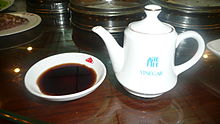Zhenjiang vinegar
This article is missing information about acid content (4.5/5.5% grades called B and K types [K型] in China; should be published in some product listing/images with the ingredients); other chemistry (aromatic compounds; look for GC-O studies); collective trademark (集体商标) and geographical protection status in China. (April 2019) |
| Zhenjiang vinegar | |||||||
|---|---|---|---|---|---|---|---|
 | |||||||
| Simplified Chinese | 镇江香醋 | ||||||
| Traditional Chinese | 鎭江香醋 | ||||||
| Literal meaning | Zhenjiang Aromatic Vinegar | ||||||
| |||||||
Zhenjiang or Chinkiang vinegar is a rice-based black vinegar widely used in Chinese cuisine. It takes its name from the city of Zhenjiang in Jiangsu province.
History[]
Chinese legend ascribes the invention of the vinegar to Heita, a son of Dukang, one of the culture heroes credited with inventing alcoholic beverages in China's prehistory. Supposedly, Heita forgot a vat of wine for 21 days and, remembering it at dusk, found it pleasantly sour. Historical records for the present vinegar can be traced back 1400 years. The primary producer of Zhenjiang vinegar at present—the Jiangsu Hengshun Vinegar Industry Company—was established in 1840.[1][2]
Production[]

Production of Zhenjiang vinegar begins when a vinegar pei mixture (wheat bran, rice hull, alcohol obtained from saccharification of glutinous rice and vinegar seed from a prior batch) is poured into an urn until the urn is half-full. The mixture is kept warm for up to 3 days in summer and 6 days in winter. At that point, rice hull is added and mixed in once per day until the urn is full. Salt is added and the urn is stored for up to 3 months during which it undergoes an aging process. The vinegar is then leached and the soaking liquid from water-soaked, parched rice is added as a color and flavor enhancer.[1]
The label in the photograph does not have any information about the percentage of acidity. The ingredients are listed as "water, glutinous rice, bran, salt, sugar" in English and French. The reverse of the bottle has the required "Nutrition Facts": a serving is 1 tablespoon, which is 5 calories; it supplies 0% of dietary requirements, except 5% of sodium.
For another bottle, an acidity of 5.5% is given.[3]
See also[]
- Chinese rice vinegars
References[]
- ^ a b Laura Solieri & Paolo Giudici (2009). Vinegars of the World. Springer Science & Business Media. pp. 254–255. ISBN 9788847008663. Retrieved 19 April 2016.
- ^ Lee, Keekok (2008). Warp and Weft, Chinese Language and Culture. Strategic Book Publishing. p. 95. ISBN 9781606932476.
- ^ https://www.gourmet-versand.com/en/article1486/black-rice-vinegar-chinkiang-vinegar-55-prozent-acidity-china-550-ml.html
- Chinese condiments
- Rice
- Vinegar
- Zhenjiang